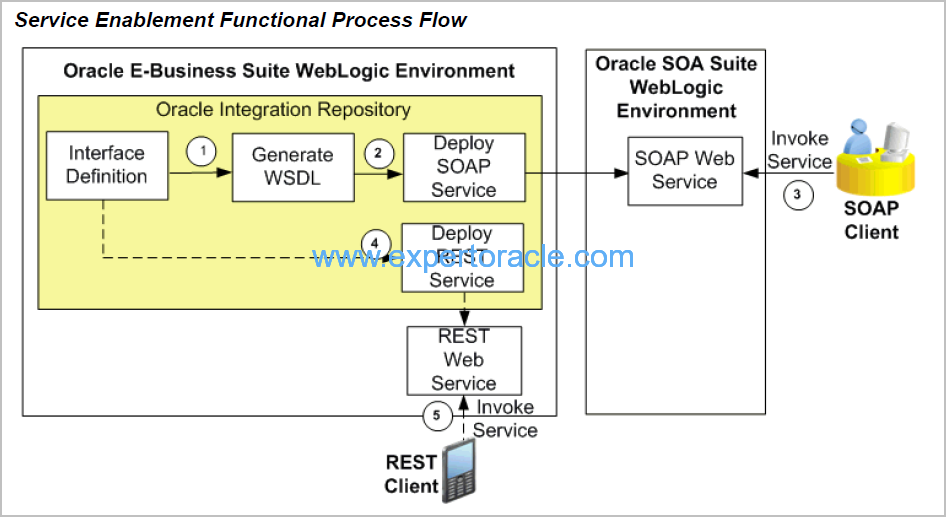We already described in earlier post what is web service. Service enablement is one of the “essential features” or “process flow” in Oracle E-Business Suite Integrated SOA Gateway. You can say it is that “magic ingredient” which allows native packaged integration interface definitions written in PL/SQL, Java, and other formats and stored in Oracle Integration Repository to be transformed into Web services.
“Service enablement” involves:
- Generating service artifacts, such as XSD
- To validate XML messages, WSDL or WADL to describe the Web service,
- Deploying web services on an application server so that the services are available to clients over the Web.
High level service enablement process flow within Oracle E-Business Suite:

Image Source: Oracle Documentation
- Interface definitions present in Oracle Integration Repository are transformed into SOAP-based services described (written) in WSDLs
- Deploy or make available the SOAP service to an Oracle SOA Suite WebLogic managed server (this is our ISG Weblogic server).
- When needed at runtime, Web service clients send inbound requests and invoke Oracle E-business Suite SOAP services through Oracle SOA Suite
4 & 5 are REST Service specific
- If the selected interfaces can be exposed as REST services, an integration administrator can deploy the REST services using a user action called ‘Deploy’. REST services described in WADLs are deployed to an Oracle E-Business Suite managed server(and NOT to the ISG SOA managed server).
- At runtime, REST services commonly used for mobile applications can create or update resources in Oracle E-Business Suite
SOAP Service Enablement
Few key points regarding SOAP Service Enablement:
- SOAP service provides a standard way of structuring documents written in XML language and acts as a building block for Web service communication
- Service provider receives SOAP requests from Web service clients and it in return sends the corresponding SOAP responses to the clients
- SOAP based service can follow synchronous (immediate response, connection remain open, client waits for response) or asynchronous (may take time to process request, client do not wait and move further) patterns
- SOAP gateway enforces security through authentication and authorization
- AUTHENTICATION: For EBS web services, must be authenticated using Username Token or SAML Token based security. Identified authentication information is embedded in the wsse: security Web Security headers
- AUTHORIZATION: For authorization, access permissions must be explicitly given to the users through security grants.
- After service generation, the WSDL URL can be used either to create clients which invoke the deployed SOAP services directly, or use Oracle SOA Suite BPEL component to create a composite application which coordinates the flow of data between various Web services to accomplish a business process
REST Service Enablement
- REST (Representational State Transfer) is an “architecture principle” in which the Web services are viewed as resources and can be accessed through specific URLs
- HTTP methods like PUT, GET etc. are used to call REST web services
- This is “simpler” alternative of SOAP web service
- REST messages are supported with XML and JSON (non-XML data) formats
- Unlike SOAP services, REST services are all generated with the support of synchronous request-response and request-only interaction patterns only
- Asynchronous interaction pattern is not supported for REST services in this release.
- SECURITY: Users who try to invoke Oracle E-Business Suite REST services must be authenticated using HTTP Basic Authentication or Token Based Authentication at the HTTP transport level.
- Web Application Description Language (WADL) is designed to provide a machine-processable description of HTTP-based Web Applications. WADL is platform and language independent and aims to promote reuse of applications beyond the basic use in a Web browser.
In coming post we will see the details Integration repository where all the web services code is located.
- Oracle Multitenant DB 4 : Parameters/SGA/PGA management in CDB-PDB - July 18, 2021
- Oracle Multitenant DB 3 : Data Dictionary Architecture in CDB-PDB - March 20, 2021
- Oracle Multitenant DB 2 : Benefits of the Multitenant Architecture - March 19, 2021

